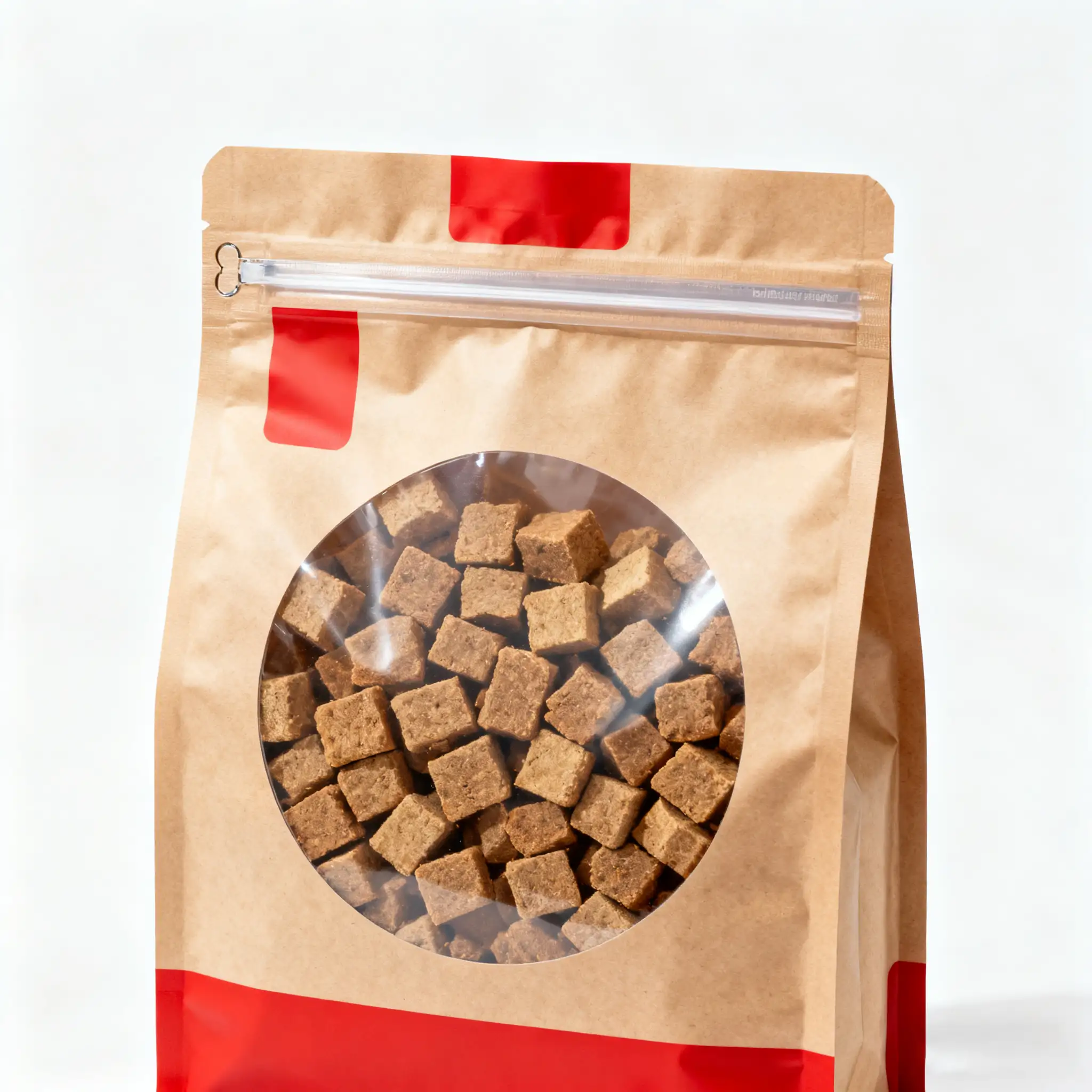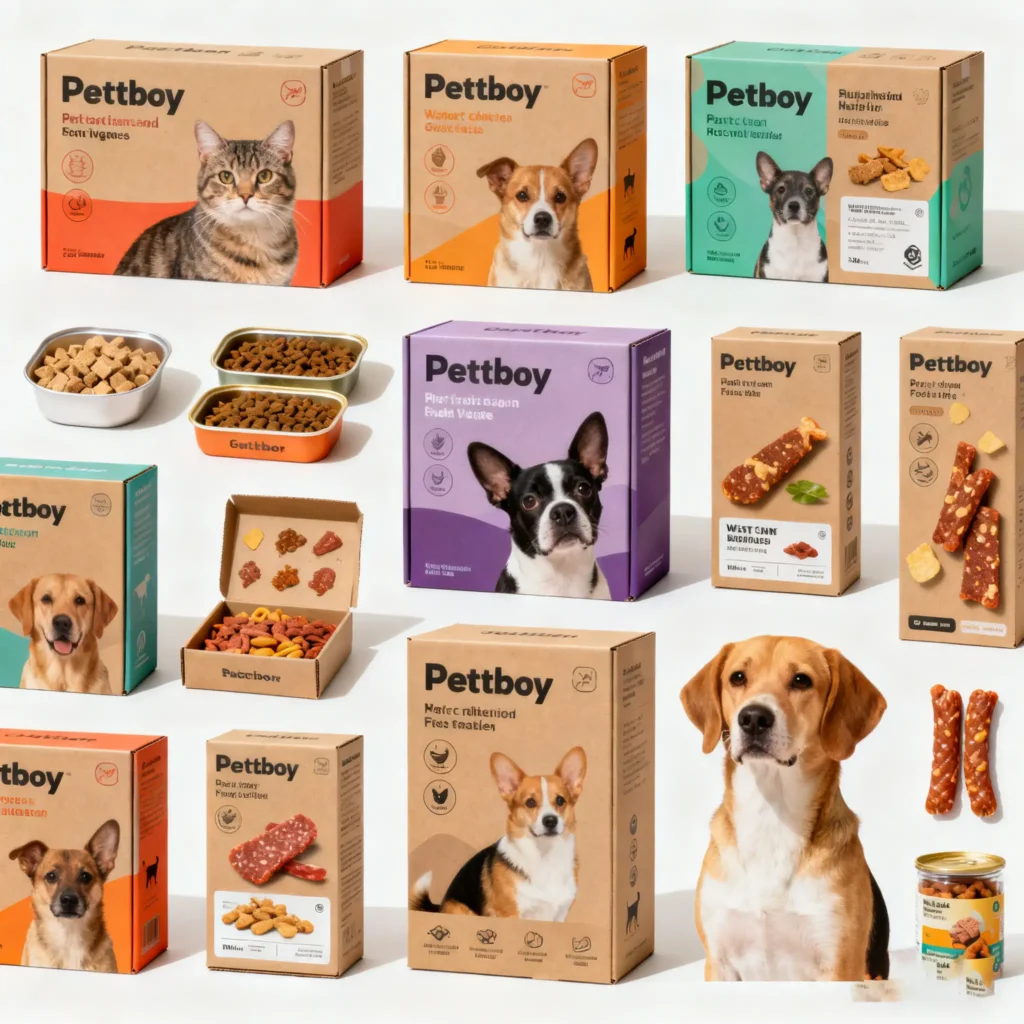Your amazing pet food formula is ready, but the packaging looks dull on the shelf. You are struggling to attract customers and your sales are not meeting expectations.
The key is to combine sustainability, convenience, and high-impact visual design. Modern pet owners look for eco-friendly materials, easy-to-use features like resealable zippers, and branding that reflects the high quality of the food inside. This approach builds trust and makes your product stand out.
 "Modern Pet Food Packaging Designs"
"Modern Pet Food Packaging Designs"
I've been in the packaging business for over 16 years, and I've seen many brands struggle with this exact problem. A great product deserves packaging that tells its story effectively. As a designer, you know that the box or bag is the first handshake with the customer. It needs to be firm, confident, and appealing. Let’s break down how you can achieve that for your pet food clients and turn their packaging into a powerful sales tool. Together, we can explore the details that make a real difference.
Is Sustainable Packaging Just a Trend, or a Must-Have?
You want to be eco-friendly, but the costs and material choices are overwhelming. It feels like a risky move when you need to keep the product safe and affordable.
Sustainable packaging is now a core expectation for many pet owners. They want to see brands using recyclable, and compostable materials. Adopting green packaging is no longer just a trend; it's essential for building a modern, responsible brand identity that attracts and retains customers.
 "Eco-Friendly Pet Packaging Materials"
"Eco-Friendly Pet Packaging Materials"
In my experience, the conversation around sustainability has shifted from "if" to "how." Pet parents, especially millennials and Gen Z, see their pets as part of the family. They apply their own purchasing values, like environmental responsibility, to the products they buy for their pets. As a designer like Peter, your challenge is to balance these consumer demands with practical production realities. You need to present options to your clients that are both green and functional. This means looking beyond just a recycling symbol. It's about understanding the entire lifecycle of the package. We can break this down to make it easier to navigate the choices and find the perfect fit for your client's brand and budget.
Choosing the Right Green Material
The first step is material selection. The goal is to protect the product while reducing environmental impact. One of the biggest shifts I've seen is toward mono-material packaging, which uses a single type of plastic like Polyethylene (PE). This makes the entire bag or pouch much easier to recycle compared to older, multi-layered plastics. Another option is using Post-Consumer Recycled (PCR) content, which gives old plastic a new life.
Communicating Your Eco-Friendly Choice
It's not enough to just use sustainable materials; you have to communicate it clearly to the customer. Your design must make the eco-friendly aspects easy to understand.
| Material Type | Key Benefit for Designers | Consumer Message |
|---|---|---|
| Mono-Material (PE/PE) | Easy to print on, good barrier properties. | "I'm 100% Recyclable" |
| PCR Content | Reduces virgin plastic use. | "Made with Recycled Materials" |
| Compostable (PLA) | Breaks down in industrial facilities. | "Compostable Packaging" |
| Paper-Based | Natural look and feel. | "Responsibly Sourced Paper" |
Your role is to integrate these messages into the design without cluttering it. Use clear icons and simple text to tell the brand's green story.
How Can Functional Design Improve the User Experience?
Pet owners get frustrated with bags that tear open unexpectedly or don't seal properly. This can lead to stale food, messy spills, and a negative perception of your product.
Incorporate features that focus on convenience and product preservation. Resealable zippers or sliders, easy-pour spouts, and durable materials for e-commerce shipping prevent frustration. These practical details create a better user experience and show customers you care about their daily routines.
 "Functional Pet Food Bag Design"
"Functional Pet Food Bag Design"
I remember a client who switched from a simple roll-down bag to one with a press-to-close zipper. Their customer complaints about stale kibble dropped to almost zero. People are willing to pay a little more for a product that makes their life easier. For a designer, this is a huge opportunity to add value beyond just the graphics. Thinking about how the customer will open, pour, and store the product every single day is crucial. It’s about creating a smooth, hassle-free interaction from the first time they open the bag to the very last scoop. Let's look at the specific features that deliver the most impact.
Features That Make a Difference
When designing for functionality, you need to think like a pet owner. What are their daily pain points? A 15kg bag of dog food is heavy and difficult to handle. A small bag of cat treats needs to stay fresh after being opened multiple times. Every product has different needs.
Here are some key features to consider:
- Resealable Closures: This is the most requested feature. Zippers, sliders, and hook-and-loop closures (like VELCRO®) keep food fresh and prevent pests. Sliders are often seen as more premium and easier to use for people with limited hand strength.
- Easy-Pour Spouts: For large, heavy bags, a built-in spout or a well-designed corner seal can make pouring controlled and mess-free. This simple feature can be a major selling point.
- Durable Structures: With the rise of e-commerce, packaging must survive the rough journey of shipping. This means using stronger films, better seals, and sometimes even a box-pouch or flat-bottom bag format that is more stable.
- Clear Windows: Pet owners want to see the product. A strategically placed window builds trust, showing the quality, shape, and size of the kibble or treats inside.
By integrating these elements, you're not just designing a container; you're designing a better product experience.
What Visual Elements Make Pet Owners Choose Your Product?
Your packaging sits on a crowded shelf next to dozens of competitors. If your design doesn't immediately communicate quality and trust, pet owners will simply look past it.
Focus on the "humanization" trend. Use high-quality imagery of healthy ingredients, clean and simple layouts, and premium finishes like matte textures or spot gloss. These elements signal that the product inside is as wholesome and cared for as human food, appealing directly to owners' emotions.
 "Appealing Pet Food Packaging Design"
"Appealing Pet Food Packaging Design"
Over the years, I've noticed a dramatic shift. Pet food packaging used to be filled with cartoon dogs and bright, loud colors. Now, the most successful brands look like they belong in a high-end grocery store. This is because pet owners, or "pet parents," see their animals as family members. They want to feed them with the same care they would feed themselves. Your design must reflect this powerful emotional connection. It’s your job, Peter, to translate the quality of the ingredients into a visual language that a customer can understand in a split second. Let's dive deeper into the specific techniques you can use.
Crafting a Premium Look and Feel
Creating a premium experience goes beyond just the logo. It involves a thoughtful combination of colors, typography, imagery, and materials.
1. Ingredient-Forward Imagery:
Instead of just showing a photo of a happy pet, showcase the beautiful ingredients inside. High-resolution photos of real chicken, sweet potatoes, and blueberries can make the food look delicious and healthy. This taps into the human food trend and instantly communicates quality.
2. Clean and Minimalist Layouts:
A cluttered design can look cheap and confusing. Use plenty of white space to give your design room to breathe. A clean layout helps the customer focus on the most important information, like the brand name and key benefits (e.g., "Grain-Free," "Real Chicken is the #1 Ingredient").
3. Tactile Finishes:
How the package feels in the customer's hands can make a huge difference.
| Finish Type | Effect | Best For |
|---|---|---|
| Matte Varnish | Soft, non-glare, premium feel. | Natural or organic brands. |
| Spot Gloss (UV) | Adds a shiny, raised texture to specific areas. | Highlighting logos or key images. |
| Soft-Touch Coating | Creates a velvety, luxurious texture. | Ultra-premium or gift-like products. |
| Embossing | Raises parts of the design for a 3D effect. | Creating a classic, established look. |
By combining these visual and tactile elements, you create a story of quality that begins the moment a customer picks your package off the shelf.
Conclusion
In short, successful pet packaging combines green materials, user-friendly features, and human-centric design. This approach will meet modern consumer demands and elevate your client's brand above the competition.






